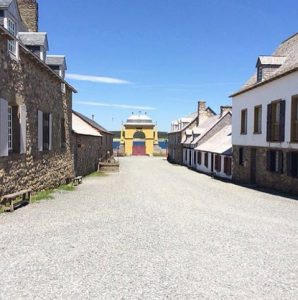Tag Archive
activity architecture art artist building Canada children city CostSaver downtown drive i-95 entertainment Europe event exhibit family festival Florida food fun historic History landmark local Museum music Nature New Zealand Ontario roadtrip sculpture Seattle show sights sightseeing tour tourist Trafalgar travel travelblogger view Washington Washington State water world
US: Dunn, NC – Visit the Home of the “Father of the Army Airborne”
General William C. Lee Airborne Museum – This house was the home of the “Father of the Army Airborne”, so the museum charts his personal life as well as the growth of Army 101st and 82nd Airborne divisions. Exhibits include photographs, videotape, World War II memorabilia, historical documents and paratrooper equipment and uniforms.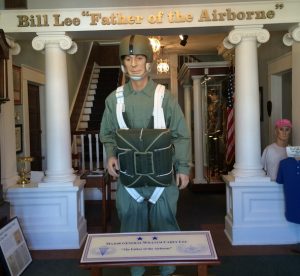
General Lee was a relentless lobbyist to make the airborne a formidable part of our military might.
At tank school in Versailles, France in the ‘30’s he observed German military airborne experiments. He saw the promise of this, and started with test platoons doing parachute jumps (practiced from parachute towers in Hightstown, NJ).
By August 1942, in 26 months, he shepherded the airborne from a test platoon of 50 men to 2 divisions of 8,300 men, and was in charge of the sky: parachutes, air landing battalions and eventually the glider units.
He suffered a major heart attack on the eve of D-Day, and missed his chance to lead it. You have probably heard of his famous saying “the 101st has no history, but it has a rendezvous with destiny”.
Location: General William C. Lee Airborne Museum, 209 West Divine St., Dunn 28334
Hours: Mon-Fri 8:30-4:30, Sat 11-4 (Closed Sundays and Holidays)
Tel: 910-892-1947
generalleeairbornemuseum.org
For Regional Accommodations, Restaurants & Attractions: dunntourism.org
Canada: Cape Breton Island, Nova Scotia – Ornate Main Gates
Looking down the length of Rue Toulouse you can see the Bourbon majesty in the ornate arch of Frederic Gate. Most of the people, news, merchandise which arrived at Fortress Louisbourg, Cape Breton, Nova Scotia, as well as orders from the king arrived through the gate. The gate’s name honors the royal minister who managed France’s colonies and navy in the 18th century.
When ships arrived, crews pushed and carried their cargo through the narrow gateway. The sailors who landed here spoke French, English, Portuguese, Basque, Breton, German, and the Mi’kmaw of the native people. The quay was a gathering place for townspeople so they would have seen public announcements, auctions and even the punishment of criminals.
Cosmos Tour: Prague Vienna Budapest – Beloved Sisi, Empress Elisabeth
Just as we have our beloved famous Disney princesses, the Austro-Hungarian Empire had theirs – but she was for real. They call her by her nickname Sisi, and she was their Empress for 44 years.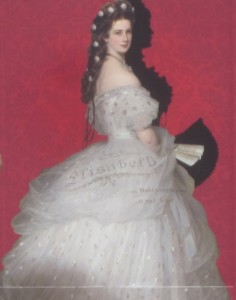
Their have been numerous movies, plays, operas, ballets, books and music about her in the German speaking world. It is probably the trilogy of romantic films about her life which starred a young Romy Schneider which made her a household name. She is so popular that the 3 movies are shown every Christmas on Austrian, German, Dutch, and French television.
Though her husband Emperor Franz Josef adored her, she felt stifled by Habsburg court life and traveled extensively whenever and wherever she could. She loved learning and spoke English, French, modern Greek and Hungarian. Her domineering mother-in-law made her life miserable and even took away her children to raise. Her first daughter died as a toddler and her beloved son Crown Prince Rudolph, heir to the throne, committed suicide along with his lover, and she never fully recovered from that loss.
Empress Elisabeth was vain and did not sit for any portraits after she was 32 and would not allow any more photographs, so that her public image would always remain of her youthful self. She was tall, and compulsively maintained the same low weight all through her life thru exercise (horsemanship, fencing, hiking) and fasting.
Her interest in politics had developed as she matured. She felt an intense emotional alliance with Hungary, and worked toward it gaining an equal footing with Austria. Elisabeth was an ideal mediator between the Magyars and the Emperor. She was a personal advocate for Hungarian Count Gyula Andrássy (he was a lifelong friend, and possibly her lover).
Finally, the Austro-Hungarian Compromise of 1867 created the double monarchy of Austro–Hungary. Andrássy was made the first Hungarian prime minister, and in return he saw that Franz Josef and Elisabeth were officially crowned King and Queen of Hungary.
Sisi was assassinated “by accident” in 1898 by Luigi Lucheni, who had planned to kill the Duke of Orleans, Pretender to France’s throne, but the Duke had left town. Despite warnings of possible assassination attempts Elisabeth, now age 60, traveled incognito to Geneva. She eschewed the protection which the Swiss government had offered and only promenaded with her lady-in-waiting.
You can visit many of her residences: her apartments in the Hofburg and the Schönbrunn Palaces in Vienna, the imperial villa in Ischl, the Achilleion in Corfu, and her summer residence in Gödöllő, Hungary.
These plaques, mounted in Vienna, tell some of her story:
Cosmos Tour: Prague Vienna Budapest – Oktoberfest
Oktoberfest began as a wedding party.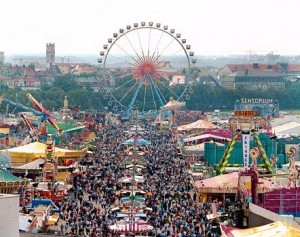
On October 12, 1810, when Crown Prince Ludwig, who later became King Ludwig I, married Princess Therese of Saxe-Hildburghausen, all the citizens of Munich were invited to the wedding!
The festivities were held in the fields in front of the city gates. The fields were named Theresienwiese (“Theresa’s meadow”) in honor of the Crown Princess, and have kept that name ever since. Locals have since abbreviated the name simply to “Wiesn” which is what locals call the festival.
Oktoberfest is not a German national event. It is a local Bavarian festival, held in Munich.
Germany: Munich Residenz
The Wittelsbach dynasty ruled the German territories of Bavaria from 1180 to 1918 – that’s 738 years, pretty impressive. Munich Residenz, their former royal palace, is located right in the center of Munich and very much open to the public. After 4 centuries of building it, the giant palace is made up of many styles: late Renaissance, Baroque, Rococo and Neo-Classicism.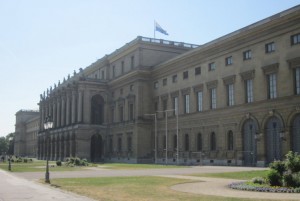
Though spartan on the outside, it is very opulent inside. You can tour it for its architecture, over-the-top room decor (130 rooms), and displays from the former royal collections. After WWII, the Cuvilliés Theatre was built into the Festsaalbau wing. You can also catch the Bavarian Radio Symphony Orchestra in Hercules Hall. In his time, Mozart performed in this palace.
The Treasury houses the jewels of the Wittelsbach dynasty and spans 1,000 years, from the early Middle Ages to Neo-classicism, and includes: crowns, swords, golden objects, rock crystal, ivory, goblets, icons, tableware and toiletries.
The palace suffered huge damages during WWII, but the curators managed to store furnishings, art and details of its architecture in mines. When you are wandering around the 10 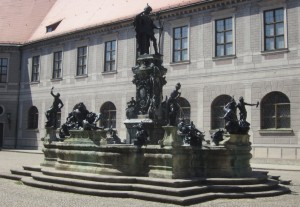 courtyards, see if you can find this fountain with statues of fire, water, earth and air on its corners.
courtyards, see if you can find this fountain with statues of fire, water, earth and air on its corners.
The Wittelsbach family’s head, since 1996, is Franz, Duke of Bavaria, and he still hangs out in Munich. During WWII, the Wittelsbachs were anti-Nazi and were arrested when Franz was 11. He spent time in several Nazi concentration camps. After the war, he studied at the University of Munich and became a collector of modern art. Some of his collection is on loan to the Pinakothek der Moderne Museum (see other post).
Germany: Munich – Jewish Premier of Germany
 Kurt Eisner, a Socialist and a Jew became the first Republican Premier of Bavaria. In November 1918, at the end of WWI, Eisner, a socialist journalist and statesman, organized the Socialist Revolution which overthrew the Wittelsbach monarchy in Bavaria. He declared Bavaria to be a free state and republic on November 8, 1918.
Kurt Eisner, a Socialist and a Jew became the first Republican Premier of Bavaria. In November 1918, at the end of WWI, Eisner, a socialist journalist and statesman, organized the Socialist Revolution which overthrew the Wittelsbach monarchy in Bavaria. He declared Bavaria to be a free state and republic on November 8, 1918.
His leadership didn’t last long as he was assassinated in Munich when German nationalist Anton Graf von Arco auf Valley shot him in the back on February 21, 1919. After his death the in-fighting amongst left wing parties led to the seeds of the National Socialist Party and the rise of Hitler.
In 1989 a memorial was placed on the sidewalk on the ground at the site of his assassination.

Members of the Wittelsbach family are still alive, still own property in the city and are honored by the people of Munich and are invited to events.
